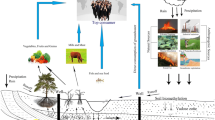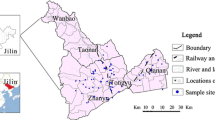Abstract
Access to safe drinking water is one of the fundamental human rights and an important component of healthy life. In this paper, the triangular fuzzy numbers approach has been used for recognizing uncertainties in the estimation of health risks proposed by the United States Environmental Protection Agency in Yinchuan city, northwest China. The levels of As, Cd, Cr, Mn, Cu, Zn, Hg, Pb, F, NO3-N, and NH4-N in drinking water were within the permissible limits except for Fe. The results showed that the health risks were primarily attributed by Cr, As, and F in drinking water. When the confidence level was 0.8, the total carcinogenic and noncarcinogenic risks values were less than the acceptable risk levels (10−4 and 1.0) set by the USEPA, respectively. The health risk of drinking water in Yinchuan city is as follows: Nanjiao water source > Beijiao water source > Dongjiao water source. Furthermore, the total noncarcinogenic risks were more sensitive with respect to different confidence levels. The spatial distribution of As and F levels in drinking water sources is urgently needed to be ascertained in drinking water, especially for Nanjiao water source. The health risk assessment model based on the triangular fuzzy numbers approach is effective to quantify uncertainty in risks with less complexity. The findings in this paper will help managers minimize the potential health risks and provide a new insight for solving uncertainties in water management.



Similar content being viewed by others
References
Ahn JS (2012) Geochemical occurrences of arsenic and fluoride in bedrock groundwater: a case study in Geumsan County, Korea. Environ Geochem Health 34:43–54. doi:10.1007/s10653-011-9411-5
Arunraj NS, Mandal S, Maiti J (2013) Modeling uncertainty in risk assessment: an integrated approach with fuzzy set theory and Monte Carlo simulation. Accid Anal Prev 55:242–255
Belkhiri L, Narany TS (2015) Using multivariate statistical analysis, geostatistical techniques and structural equation modeling to identify spatial variability of groundwater quality. Water Resour Manag 29(6):2073–2089. doi:10.1007/s11269-015-0929-7
Bortey-Sam N, Nakayama SMM, Ikenaka Y, Akoto O, Baidoo E, Mizukawa H, Ishizuka M (2015) Health risk assessment of heavy metals and metalloid in drinking water from communities near gold mines in Tarkwa, Ghana. Environ Monit Assess 187:389. doi:10.1007/s10661-015-4630-3
Bureau of Quality and Technical Supervision of China (1993) National standard of the People’s Republic of China: quality standard for groundwater, GB/T 14848–93 (in Chinese)
Chen J, Wu H, Qian H (2016a) Groundwater nitrate contamination and associated health risk for the rural communities in an agricultural area of Ningxia, northwest China. Expo Health. doi:10.1007/s12403-016-0208-8
Chen J, Wu H, Qian H, Gao Y (2016b) Challenges and prospects of sustainable groundwater management in an arid region along the Silk Road economic belt, northwest China. Int J Water Resour Dev. doi:10.1080/07900627.2016.1238348
Chen J, Wu H, Qian H, Gao Y (2017a) Assessing nitrate and fluoride contaminants in drinking water and their health risk of rural residents living in a semiarid region of Northwest China. Expo Health. doi:10.1007/s12403-016-0231-9
Chen J, Qian H, Wu H (2017b) Nitrogen contamination in groundwater in an agricultural region along the New Silk Road, northwest China: distribution and factors controlling its fate. Environ Sci Pollut Res 24(15):13154–13167. doi:10.1007/s11356-017-8881-0
Chen J, Qian H, Wu H, Gao Y, Li X (2017c) Assessment of arsenic and fluoride pollution in groundwater in Dawukou area, Northwest China, and the associated health risk for inhabitants. Environ Earth Sci. doi:10.1007/s12665-017-6629-2
Dragon K (2012) Groundwater nitrate pollution in the recharge zone of a regional Quaternary flow system (Wielkopolska region, Poland). Environ Earth Sci 68:2099–2109. doi:10.1007/s12665-012-1895-5
Dubois D, Prade H (1978) Operations on fuzzy numbers. Int J Syst Sci 9(6):613–626
Dutta P, Boruah H, Ali T (2011) Fuzzy arithmetic with and without using a-cut method: a comparative study. Int J Latest Trends Comput 2(1):99–107
Fogden J (2009) Access to safe drinking water and its impact on global economic growth. HaloSource Inc., London
Gao S, Zhang Z (2009) Multiplication operation on fuzzy numbers. J Softw 4(4):331–338
Gardner MJ, Altman DG (1986) Confidence intervals rather than P values: estimation rather than hypothesis testing. Br Med J 292:746–750. doi:10.1136/bmj.292.6522.746
Geng M, Qi H, Liu X, Gao B, Yang Z, Lu W, Sun R (2016) Occurrence and health risk assessment of selected metals in drinking water from two typical remote areas in China. Environ Sci Pollut R 23(9):8462–8469. doi:10.1007/s11356-015-6021-2
Han S, Zhang F, Zhang H, An Y, Wang Y, Wu X, Wang C (2013) Spatial and temporal patterns of groundwater arsenic in shallow and deep groundwater of Yinchuan Plain, China. J Geochem Explor 135:71–78. doi:10.1016/j.gexplo.2012.11.005
Hunter PR, Fewtrell L (2001) Acceptable risk. In: Fetrell L, Bartram J (eds) Water quality: guidelines, standards and health. IWA Publishing, London, pp 207–227
IARC (1993) Cadmium and cadmium compounds, beryllium, cadmium, mercury and exposure in the glass manufacturing industry. IARC Monogr Eval Carcinog Risks-Hum 58:119–137
Jadhav SV, Bringas E, Yadav GD, Rathod VK, Oritz I, Marathe KV (2015) Arsenic and fluoride contaminated groundwaters: a review of current technologies for contaminants removal. J Environ Manag 162:306–325. doi:10.1016/j.jenvman.2015.07.020
Jin J, Wei Y, Zou L, Liu L, Fu J (2012) Risk evaluation of China’s natural disaster systems: an approach based on triangular fuzzy numbers and stochastic simulation. Nat Hazards 62(1):306–325. doi:10.1007/s11069-011-0005-4
Khan S, Shahnaz M, Jehan N, Rehman S, Shah MT, Din I (2013) Drinking water quality and human health risk in Charsadda district, Pakistan. J Clean Prod 60:93–101
Li J, Huang G, Zeng G, Maqsood I, Huang Y (2007) An integrated fuzzy-stochastic modeling approach for risk assessment of groundwater contamination. J Environ Manag 82:173–188. doi:10.1016/j.jenvman.2005.12.018
Li P, Wu J, Qian H, Lyu X, Liu H (2014) Origin and assessment of groundwater pollution and associated health risk: a case study in an industrial park, northwest China. Environ Geochem Health 36(4):693–712. doi:10.1007/s10653-013-9590-3
Li P, Qian H, Howard KWF, Wu J (2015) Building a new and sustainable Silk Road economic belt. Environ Earth Sci 74(10):7267–7270. doi:10.1007/s12665-015-4739-2
Li P, Wu J, Qian H (2016a) Hydrochemical appraisal of groundwater quality for drinking and irrigation purposes and the major influencing factors: a case study in and around Hua County, China. Arab J Geosci 9(1):15. doi:10.1007/s12517-015-2059-1
Li P, Li X, Meng X, Li M, Zhang Y (2016b) Appraising groundwater quality and health risks from contamination in a semiarid region of northwest China. Expo Health 8(3):361–379. doi:10.1007/s12403-016-0205-y
Li Y, Zhang Z, Fei Y, Chen H, Qian Y, Dun Y (2016c) Investigation of quality and pollution characteristics of groundwater in the Hutuo River alluvial plain, North China Plain. Environ Earth Sci 75:581. doi:10.1007/s12665-016-5366-2
Li P, Tian R, Xue C, Wu J (2017a) Progress, opportunities and key fields for groundwater quality research under the impacts of human activities in China with a special focus on western China. Environ Sci Pollut Res 24(15):13224–13234. doi:10.1007/s11356-017-8753-7
Li P, Qian H, Zhou W (2017b) Finding harmony between the environment and humanity: an introduction to the thematic issue of the Silk Road. Environ Earth Sci 76(3):105. doi:10.1007/s12665-017-6428-9
Ministry of Water Resources of PRC (1997) Technical regulation of water quality sampling (SL 187–96). Standards Press of China, Beijing (in Chinese)
Nawab J, Khan S, Ali S, Sher H, Rahman Z, Khan K, Tang J, Ahmad A (2016) Health risk assessment of heavy metals and bacterial contamination in drinking water sources: a case study of Malakand Agency, Pakistan. Environ Monit Assess 188:286. doi:10.1007/s10661-016-5296-1
Ningxia statistical Bureau (2013) Ningxia statistical yearbook. China Statistics Press, Beijing (in Chinese)
Ohio Environmental Protection Agency (EPA) (2014) Reduction–oxidation (redox) control in Ohio’s ground water quality. J Environ Manag 139:97–108
Qian H, Li P, Howard KWF, Yang C, Zhang X (2012) Assessment of groundwater vulnerability in the Yinchuan plain, northwest China using OREADIC. Environ Monit Assess 184(6):3613–3628. doi:10.1007/s10661-011-2211-7
Radloff KA, Zheng Y, Michael HA, Stute M, Bostick BC, Mihajlov I, Bounds M, Huq MR, Choudhury I, Rahman MW, Schlosser P, Ahmed KM, Geen A (2011) Arsenic migration to deep groundwater in Bangladesh influenced by adsorption and water demand. Nat Geosci 4(11):793–798. doi:10.1038/ngeo1283
Rango T, Kravchenko J, Atlaw B, McCornic PG, Jeuland M, Merola B, Vengosh A (2012) Groundwater quality and its health impact: an assessment of dental fluorosis in rural inhabitants of the Main Ethiopian Rift. Environ Int 43:37–47. doi:10.1016/j.envint.2012.03.002
Rathnayaka K, Malano H, Arora M (2016) Assessment of sustainability of urban water supply and demand management options: a comprehensive approach. Water 8(12):595. doi:10.3390/w8120595
Schmoll O, Howard G, Chilton J, Chorus I (2006) Protecting Groundwater for health. IWA publishing, London
Smith AH, Lingas EO, Rahman M (2000) Contamination of drinking water by arsenic in Bangladesh: a public health emergency. Bull World Health Organ 78(9):1093–1103
Suthar S, Bishnoi P, Singh S, Mutiyar PK, Nema AK, Patil NS (2009) Nitrate contamination in groundwater of some rural areas of Rajasthan, India. J Hazard Mater 171:189–199. doi:10.1016/j.jhazmat.2009.05.111
Tchounwou PB, Yedjou CG, Patloll AK, Sutton DJ (2012) Heavy metals toxicity and the environment. EXS 101:133–164. doi:10.1007/978-3-7643-8340-4_6
United Nations (1977) Report of the United Nations water conference. United Nations Publications, New York, Mar del Plara
USEPA (1989) Risk assessment guidance for superfund, vol I., Human health evaluation manual (Part A). Office of Emergency and Remedial Response, Washington, DC
USEPA (2012) Integrated risk information system. United States Environmental Protection Agency. http://cfpub.epa.gov/ncea/iris/index.cfm?fuseactioniris.showSubstanceList. Accessed 3 May 2012
Wang L, Hu F, Yin L (2013) Hydrochemical and isotopic study of groundwater in the Yinchuan plain, China. Environ Earth Sci 69(6):2037–2057. doi:10.1007/s12665-012-2040-1
Wang H, Lu X, Du Y, Zhang C, Sadiq R, Deng Y (2014) Fault tree analysis based on TOPSIS and triangular fuzzy number. Int J Syst Assur Eng Manag. doi:10.1007/s13198-014-0323-5
Wen D, Zhang F, Zhang E, Wang C, Han S, Zheng Y (2013) Arsenic, fluoride and iodine in groundwater of China. J Geochem Explor 135:1–21. doi:10.1016/j.gexplo.2013.10.012
World Health Organization (WHO) (1996) Guidelines for drinking-water quality, 2nd edn, vol 2. Health criteria and other supporting information. World Health Organization, Geneva
World Health Organization (WHO) (2011) Guidelines for drinking water quality, vol 4
World Health Organization (WHO) (2015) The United Nations world water assessment program report 2015: water for a sustainable world. United Nations Educational, Scientifc and Cultural Organization (UNESCO), Paris
Yang X, Ding J, Hou H (2013) Application of a triangular fuzzy AHP approach for flood risk evaluation and response measures analysis. Nat Hazards 68(2):657–674. doi:10.1007/s11069-013-0642-x
Zadeh LA (1965) Fuzzy set. Inf Control 8(3):338–353
Zheng Y, Ayotte JD (2015) At the crossroads: hazard assessment and reduction of health risks from arsenic in private well waters of Northeastern United States and Atlantic Canada. Sci Total Environ 505:1237–1247. doi:10.1016/j.scitotenv.2014.10.089
Zhou Y, Wei A, Li J, Yan L, Li J (2017) Groundwater quality evaluation and health risk assessment in the Yinchuan region, northwest China. Expo Health 8(3):443–456. doi:10.1007//12403-016-0219-5
Acknowledgements
The research was supported by the National Natural Science Foundation of China (41572236 and 41172212), the Doctoral Postgraduate Technical Project of Chang’an University (2014G5290005), and the Foundation for the Excellent Doctoral Dissertation of Chang’an University (310829150002 and 310829165005). Anonymous reviewers are sincerely acknowledged for their valuable comments.
Author information
Authors and Affiliations
Corresponding author
Rights and permissions
About this article
Cite this article
Chen, J., Qian, H., Gao, Y. et al. Human Health Risk Assessment of Contaminants in Drinking Water Based on Triangular Fuzzy Numbers Approach in Yinchuan City, Northwest China. Expo Health 10, 155–166 (2018). https://doi.org/10.1007/s12403-017-0252-z
Received:
Revised:
Accepted:
Published:
Issue Date:
DOI: https://doi.org/10.1007/s12403-017-0252-z




